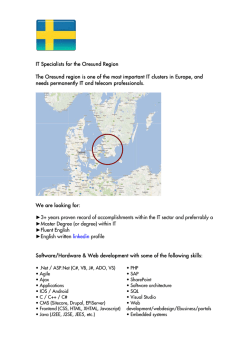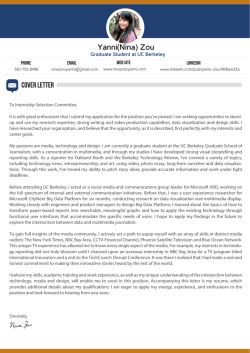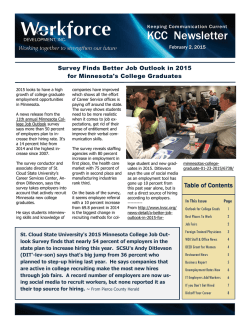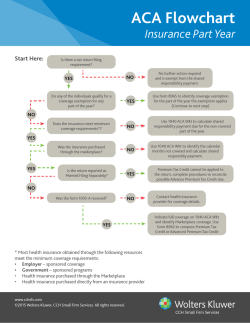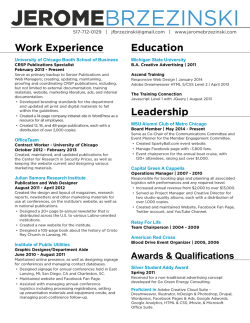
Page Three
SUNDAY, FEBRUARY 1, 2015 WSJ 3 3 1 ‘We say social network; you say jobs site.’ LinkedIn markets itself as a “social network and online platform for professionals” and is often mentioned in the same breath as Facebook and Twitter. But analysts say that it’s more of a traditional jobs site than a social network. Indeed, many people spend time rejecting invitations from total strangers. “It’s not a social network at all,” says Jeremy Roberts, editor of SourceCon, a blog and conference series for recruiters. A jobs site doesn’t earn as much from advertisers as a social network, and instead charges recruiters and corporations for products and services. Others say LinkedIn—which has more than 330 million members world-wide, 100 million in the U.S.—is both a social network and jobs site, as people join industry groups and keep tabs on professional contacts. “You might be looking for a job, but we want to be able to give our members the tools to be better at their job as well,” says LinkedIn spokeswoman Crystal Braswell. 2 ‘People don’t really hang out on LinkedIn.’ Members using mobile devices spent 14 to 20 minutes a month on LinkedIn during October, November and December 2014, according to data released to MarketWatch by research group Nielsen. This compares to more than one hour on Twitter and around 10 hours on Facebook. “People don’t really spend a lot of time on LinkedIn,” says Tim Sackett, president of HRU Technical Resources, an information-technology and engineering staffing firm in Lansing, Mich. LinkedIn’s news feed trends more toward work anniversaries, updates about work/ life issues and stories about networking with LinkedIn. The quality of the time spent is more important, especially on a mobile device, Ms. Braswell says. “LinkedIn helps people to become more productive.” ‘Thanks for all the free content.’ Many LinkedIn users try to gild their professional reputations by publishing blog posts on the site, but few are likely to get the viral impact they’re looking for. “The number of connections you have does matter,” says John Bonini, content-marketing manager of Impact Branding & Design in Wallingford, Conn. One reason: sheer volume. LinkedIn publishes around 40,000 long-form posts a week. Given the competition, LinkedIn’s news aggregator “Pulse”—which members can receive via email—is the golden egg for those hoping to go viral. 4 ‘Endorsements are only good for your ego.’ LinkedIn has made it easy to endorse people on the site, clicking on skills that you can add to a contact’s profile. When you accept an endorsement on LinkedIn, a new panel pops up: “Now it’s your turn. Endorse your connection.” But the more you endorse people for suggested skills, the more members pop up in their place. Critics say this virtual back-scratching turns into a never-ending game of whack-amole. “Valid third-party recommendations are useful,” says Jenny Foss, president of the Ladder Recruiting Group in Portland, Ore. Recommendations—more detailed mini-references that appear on your profile—are especially useful if they’re written by a well-respected figure in your field. 5 ‘Our site is complex and confusing.’ If the difference between endorsements and recommendations sounds confusing, it gets worse the deeper you get into the site. LinkedIn can be overwhelming to users partly because it tries to fulfill different services for job seekers, companies and recruiters. LinkedIn rated No. 84 out of 90 on the “Global Brand Simplicity Index 2014” by brandgrowth firm Siegel + Gale. Users complained about the complex navigation and excessive emails. Robert Babboni BY QUENTIN FOTTRELL ... LinkedIn Won’t Tell You 6 ‘We get a free pass when it comes to privacy.’ LinkedIn’s privacy policy is just as long as Facebook’s and is regularly updated, but analysts say the site’s constant data mining doesn’t get as much attention as data mining on Mark Zuckerberg’s social network. LinkedIn has been successful at convincing users that public is better than private, Mr. Bonini says: “It brings out the vanity in all of us.” Hence, all those unwanted invitations from networkers, salesmen and recruiters. Of course, LinkedIn and Facebook are very different animals. LinkedIn profiles don’t typically contain such personal information. It makes money selling access to recruiters. 7 ‘Our needy members will creep you out.’ LinkedIn members often have something to sell when they contact you. Members usually connect with potential business contacts, people in their industry and potential employers. “People do want something STARTING OUT Stuck in a Loser Job? It Gets Better. BY ANNA PRIOR Long hours, little pay, having to wait for benefits to kick in, being the lowest person on the totem pole. Your first job out of college is likely to be anything but glamorous. But I’m here to tell you—it gets better. I started my career as a news assistant for the Sunday Journal, writing this column and others, ordering office supplies, managing payroll and other administrative duties. Eager to work for such a respected newspaper, this was my dream job right out of college. But it came with challenges, from having to stay late every Friday, to a four-hour roundtrip commute, having to spend Christmas Eve in the office instead of with my family, and trying to figure out how to stretch an assistant’s salary in one of the country’s most expensive metro areas. Fast-forward six years. While the hours can still be late—and I’m still not making Mark-Zuckerberg-style money—I’m no longer the new kid in the office, and I’ve been able to build on those early experiences. Here are what some career coaches, consultants and other experts have to say about making the most of your first job and getting to a better place. Have Patience A press of a button can bring us everything from groceries to a new shirt within hours. But experts warn that first-time employees shouldn’t expect the same sort of instant gratification when it comes to their first jobs. Many millennials often get frustrated when they feel like their duties and responsibilities don’t reflect their capabilities, says Lindsey Pollak, New Yorkbased author of “Becoming the Boss: New Rules for the Next Generation of Leaders.” The trick, she says, is to have patience, recognize the source of this frustration, and channel efforts into viewing everything at the start of a career as a learning opportunity. “Training and development is not always fun, but it’s how you learn,” she says. Seek Out a Mentor A mentor can be invaluable, so experts advise seeking out a colleague or even someone out- when they email you,” says John Derrico, vice president of sales operations and client services at StatSocial, a socialaudience data and analytics firm. Only premium members get to see everyone who views their profile. And the mysterious silhouettes under “Who’s Viewed Your Profile” can spook some users. LinkedIn members can adjust their own settings so people can’t see whom they’re looking at, says Ms. Braswell. But she adds: “Don’t you want the potential hiring manager to know that you’ve done your homework? 8 ‘Fake profiles are getting out of control.’ LinkedIn is no stranger to fake profiles, and some recruiting pros say the problem is getting worse. If a very attractive executive—physically and professionally—tries to make a connection with Mr. Sackett—the Michigan-based recruiter—he assumes it’s a “catfish,” a company or person masquerading as an influential business contact. LinkedIn is not alone here. Facebook recently estimated that between 5.5% and 11.2% of its profiles are fake. At LinkedIn, that percentage would mean 18 million to 37 million fake profiles. LinkedIn acknowledges the existence of fake profiles and says it’s trying to fix the problem. 9 ‘We need to attract younger users.’ Younger users are key to membership growth, but LinkedIn is the only one of the top-five online platforms where members are likely to be aged 30 to 64 rather than 18 to 29, according to a Pew Research Internet Project survey. Only 23% of LinkedIn users are aged 18 to 29, while 61% are aged 30 to 64 and 21% are 65 and over. In August 2013, LinkedIn updated its terms of service to extend membership to those as young as 14 years of age in the U.S., Canada, Spain, Germany, Australia and South Korea, 16 in the Netherlands, 18 in China and 13 in all other countries. LinkedIn’s Ms. Braswell declined to give the company’s own user-age figures, but said it has around 40 million students and recent college graduates. 10 ‘Our share price has plateaued.’ LinkedIn’s share price has more than doubled since its initial public offering in May 2011, but it’s barely budged in the past 12 months. The company sells products to recruiters and premium subscription services, says Rick Summer, a senior equity manager at Morningstar, and must continue to convince subscribers that they’re worth paying for if it wants to increase profits, membership and share price. “It’s not as easy as a Facebook or Google model, where everything is advertising-supported,” Mr. Summer says. “The challenge [for analysts covering the stock] is figuring out what it’s all worth.” Several major brokerage firms remain bullish on LinkedIn. Membership grew more than 6% in the third quarter over the previous quarter, the first time in a year that growth had exceeded the previous quarter. REPORTING SO POWERFUL, ITJUMPS RIGHT OFF THE PAGE. Andy Ward side of your company and industry whom you admire and feel comfortable speaking with. On a more practical level, a mentor could also be in a position to put in a good word for you at the right place and time, even if your mentor is outside of your company, says Win Sheffield, a New York career coach. Even something as informal as modeling the behaviors of those you look up to at the office can be beneficial, says Ms. Pollak. How do co-workers dress? Are their emails informal or conversational? Do they come early or late to meetings? Do they take notes or not? Says Ms. Pollak: “Pay attention to the culture of your workplace and the habits of the people who succeed.” Network, Network, Network Beyond finding role models at work, it’s important to network to get a sense of what other opportunities might be out there for the future, especially if you feel bogged down in your current role. Mr. Sheffield—the career coach—suggests starting small with just a group of friends. Chat about work and their experiences, see what they’re learning and what sorts of challenges they face, and then expand to networking events and other more formal professional gatherings. Set a goal of trying to network once a month. “If you do it on a regular basis and keep it very low-key, then you’re going to have a much better sense of where you’re situation stacks up compared to others,” says Mr. Sheffield. Get Benefits When You Can From health care to a 401(k) plan and vacation days, you might have to do some time before all of your benefits become available. “The company is making an investment in you as much as you are in them, and they are testing the relationship just like you are,” says Susan LaMotte, a workforce consultant in Washington, D.C. The Affordable Care Act, which allows for children to stay on their parents’ insurance until age 26, has helped ease the burden of waiting for health care, but be sure to read up on all of the benefits your company offers and understand when you’re eligible to take advantage of them. And don’t be afraid to ask questions, whether it’s reaching out to human resources, or another younger colleague who has been there a year or so and is likely to have an understanding of how things work. Missing my family’s Christmas Eve celebration that first year was tough. But this year, I have 31 days off. Now I just have to figure out how to use them. Email: [email protected] INTRODUCING THE NEW WSJ APP FOR iOS. The new WSJ app delivers all the world-class reporting you need, with enhanced features and visual storytelling that bring the Journal to life. And it’s all delivered in a clean, simple interface. What’s more, we’ll also include a year’s subscription to Evernote Premium* — your ultimate productivity tool. So go ahead, fuel your ambition anytime. Anywhere. *A complimentary one year subscription to Evernote Premium is currently available only to U.S. subscribers who are eligible for WSJ+. To activate your Evernote Premium subscription, you must join WSJ+ and follow the activation process described at wsjplus.com. To take advantage of a full year of complimentary access to Evernote Premium, you must continue past the initial trial period of your WSJ subscription. ©2015 Dow Jones & Co., Inc. All rights reserved. 3DJ174
© Copyright 2025
